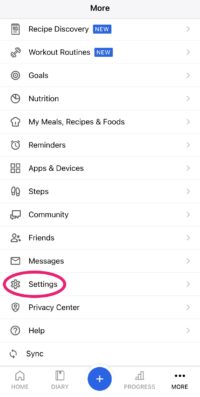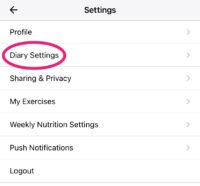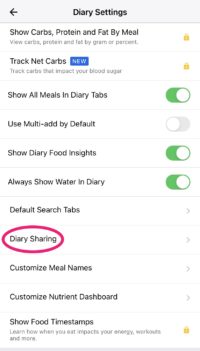What’s MyFitnessPal?
MyFitnessPal is a free calorie and fitness tracker, allowing you to track progress towards your nutrition, water, fitness, weight loss/gain goals. This health app focuses on making sure that you can log your meals as quickly and easily as possible by providing a searchable food database of 300,000,000+ food items (it is constantly being updated every day). You may also add your own foods and recipes at any time! On your account, you may customize your own unique nutrition and fitness goals- by recording everything you are more likely to stay on track with your health goals. Signing up for MyFitnessPal is completely free, but if you choose to sign up for their premium version (currently $9.99 per month or $49.99 per year), you will get access to even more features such as the breakdown of carbohydrates, fats, and proteins that you consume.
Downloading MyFitnessPal For Mobile
This health app is available on iOS, Android, and over the web. To download the mobile app for your phone, simply go onto your device’s app store and type in “MyFitnessPal,” the logo should look like the one in the picture below. After you download and open the app, you can sign up for your free account and get started with your food diary.
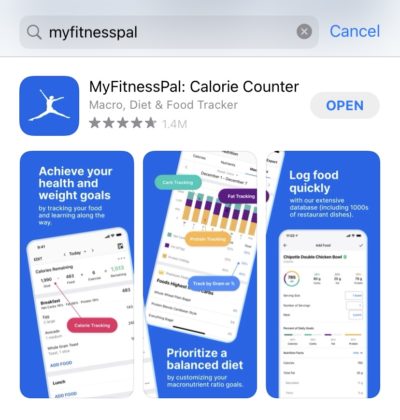
“MyFitnessPal: Calorie Counter” should look like this in your app store. Begin the download, open the app, and follow the process to sign-up for a free account!
If you are viewing this article on your selected mobile device that you would like to download the MyFitnessPal app on, simply click these quick links below for more information and to direct you to the correct app store. This resource also works over the web if you choose to track on your desktop, find their website right here.
Download MyFitnessPal for iPhone
Download MyFitnessPal for iPad
Download MyFitnessPal for Android
Food Diary Diet Tracking
In the app, you may track your daily food and drink intake in the “Diary” tab (located on the bottom bar). Here, you will find four different meal categories: breakfast, lunch, dinner, and snacks. There is also a section for exercise and water.
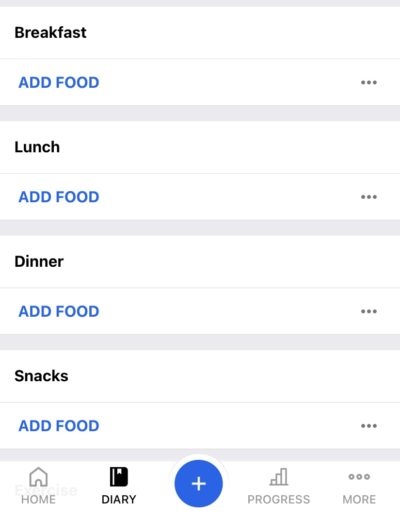
After clicking on the “Diary” tab at the bottom, you will see this screen with the different meals you can add throughout your day.
When adding food into your diary, you will be presented with a screen where you can add your item in multiple ways, this includes searching for it by name or scanning the barcode of a pre-packaged item. If you are on the premium plan of MyFitnessPal, you will also be presented with the “scan a meal” option or using the “quick add” option. Once you add an item to your diary, its nutritional information is subtracted from your daily macro goals and calories (which can be found at the top of your diary). You may view your progress towards certain nutrient goals such as protein, carbs, fat as well as vitamins and minerals.
These individual goals are determined when you sign-up for your account, but you may change your daily goals by clicking “More” > “Goals” > and here you may edit your nutrition goals, activity levels, current weight, goal weight, and more!
What Are Macros And Why Should I Be Tracking Them?
Macro is short for macronutrient (the three categories of nutrients you eat the most and provide the most energy). These three categories are proteins, carbohydrates and fats- so when you are tracking your macros, you are counting how many grams of proteins, carbs or fats that you are consuming each day. Keeping track of your macros can help you understand where your calories are coming from and how they may affect your body. There is no “standard” amount of macros a person should eat because it all varies from person to person- it truly depends on your weight, activity levels, age, personal goals, etc.
Carbohydrates are essentially sugar molecules- and carbohydrates that include longer sugar molecules are called complex carbohydrates and take longer to be broken down by the body. Complex carbohydrates are considered healthier than simple carbohydrates (which are quickly broken down by the body and spikes blood sugar). Complex carbohydrates can be found in foods such as oatmeal, rice, quinoa, vegetables, fruits, and lentils. Carbs can be divided into these three categories:
- Fiber. This is a complex carbohydrate that the body can’t digest- it helps keep you feeling full and keeps blood sugar levels from rising sharply. Fiber can be found in certain fruits, vegetables and whole grains.
- Starches. This is also a complex carbohydrate and can be found in foods such as grains, oats, corn and potatoes. Refined starches (found in rice or white flour) act like a simple carb and cause your blood sugar to rise faster. For more on resistant starches, feel free to check here.
- Sugar. These are simple carbs naturally found in fruits and vegetables. Sugars give foods their sweet taste and give the body quick energy!
Fats have 9 calories per gram compared to 4 calories per gram of carbohydrates or proteins, but healthy fats are an important part of a balanced diet! Some sources of healthy fats include nuts/nut butters, seeds, and oily fishes such as salmon, sardines, trout and tuna. Fats can be broken up into these categories:
- Trans fats. These fats have no health benefits and are commonly found in processed foods and fried foods. If possible, try to eliminate or limit trans fats from your diet.
- Saturated fats. These fats are typically found in animal products and oils, including milk, cheese, butter, and meats (pork, beef, lamb, poultry). It is best to limit saturated fat intake and replacing it with nutrient-dense food options to help decrease heart risk and promote overall health.
- Unsaturated fats. These are healthy fats mainly found in plant foods such as nuts and avocados. Omega-3 fatty acids are found in fatty fish and flaxseeds & omega-6 fatty acids are found in certain nuts and oils.
Proteins are made up of varying combinations of amino acids and can be found in almost all types of food. Proteins are considered high quality when they provide us with amino acids all of us require to function- when foods contain all of the essential amino acids that we need, they are considered a “complete protein.” These complete proteins are found in meats and eggs- and while most common sources of protein are from meats and animal based products, protein can also be found in plants and grains.
***You can view or edit your macro distribution in your MyFitnessPal app by clicking on “Goals,” where you’ll see your “Daily Nutrition Goals.”
On Tracking Alcohol
As mentioned, everything we eat or drink is made up of calories that come from either fat, carbs, and protein or some combination of those three. Alcohol is the exception. Alcohol is actually its own macronutrient.
When tracking alcohol, we take the calories in the alcohol and convert it into either carbs or fats- you never want to convert alcohol calories to protein grams. On MyFitnessPal, keep in mind that there are entries where the serving size is 100 calories and they have it already split between carbs and fats for you, no math required. See below to see how to convert calories from alcohol into either fat or carbs.
As a fat:
- Divide total calories by 9.
- Enter resulting number as fat macros
As a carbohydrate:
- Divide total calories by 4.
- Enter resulting number as carb macros
As a mix of fat and carbohydrates:
- Divide total calories by 2.
- Divide one of the halves by 9 and enter resulting number as fat macros.
- Divide other half by 4 and enter resulting number as carb macros.
How To Share Your Food Diary
An easy way to share your food diary with others is to send them your unique diary link, this allows anyone with the link to see your food diary as you keep adding data into your app. Here are the steps to setup your account to be able to share your daily diary with others.
- First, you will need to make sure your “Diary Sharing” setting is set to public. In your navigation bar at the bottom, click “more” > “settings” > “diary settings” > “diary sharing” > “public”
After your settings are changed to public, you may now share your link for anyone who you would like to view your food diary. Take note of what your username is by going back to the “more” screen (your username is underneath your picture). To make your URL link, copy this link here, but replace USERNAME with your own username.
www.myfitnesspal.com/food/diary/USERNAME
If you would like to share a certain date with someone, you may use this URL here (replace the 2022-01-22 with the year-month-day):
www.myfitnesspal.com/food/diary/USERNAME?date=2022-01-22
Quick tip: you can save your unique Food Diary URL into your Notes app on your iPhone or an equivalent app on Android (with your username already input). Now you can refer to that note and copy and paste your URL from there and all you have to do is update the last day’s date to the current date that you are posting about!
____
More Resources
- Diet Philosophy: Drop The Dogma & Discover What Works For YOU
- Diet Philosophy Part II: On Personalization
- Gluten-Free and Dairy-Free Diet
- Resistant Starch Made Practical
- The Heart Based Practice, A Simple 3 Min. Meditation
Resources From Dr. Brooke Stuart / Let Go & Grow®
- For more holistic resources, sign up for our Free Let Go & Grow® Membership, where you will receive instant access to the heart based practice, a simple 3 min. meditation, a wellness workshop designed to optimize mental health & well-being, and so much more.
- For Let Go & Grow Publishing House books including the LG&G Holistic Guide Book, LG&G Journal, and the children’s book series Let’s Grow With Zo, check here.
- For more information, support and a tried and true springboard that can help you address the fundamentals and unlock your power to heal, make sure to schedule a free holistic consultation and check out our Let Go & Grow® Mind Body Reset, a 6 week reset program. To learn more about holistic healthcare and working with Dr. Brooke in private practice, check here.


